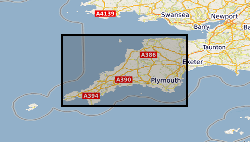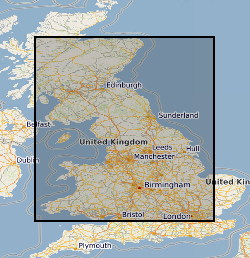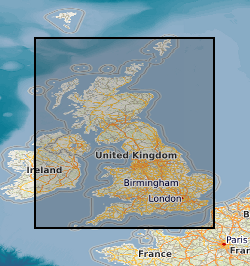Stream sampling
Type of resources
Available actions
Topics
Keywords
Contact for the resource
Provided by
Years
Formats
Representation types
Update frequencies
Service types
Scale
Resolution
-

[This metadata record has been superseded, see http://data.bgs.ac.uk/id/dataHolding/13480412].The G-BASE programme involves systematic sampling and the determination of chemical elements in samples of stream sediment, stream water and soil, to build up a picture of the surface chemistry of the UK. G-BASE for SW England is the most recent area of the UK sampled by this on-going project The average sample density for stream sediments is approximately one site per 2km square. Density for soils in SW England is variable across the area, ranging from 1 per 2km square to one per 5km square, depending on underlying parent material. Analytical precision is high with strict quality control to ensure countrywide consistency. Results have been standardised to ensure continuity with existing G-BASE geochemical data. The data provide baseline information on the natural abundances of elements, against which anomalous values due to such factors as mineralisation and industrial contamination may be compared. Analytical data for the sub150 microns fraction of stream sediment and the sub 2mm fraction of soil samples are available for some or all of: Ag, Al, As, Ba, Bi, Br, Ca, Cd, Ce, Cl, Co, Cr, Cs, Cu, Fe, Ga, Ge, Hf, I, In, K, La, Mg, Mn, Mo, Na, Nb, Nd, Ni, P, Pb, Rb, S, Sb, Sc, Se, Si, Sm, Sn, Sr, Ta, Te, Th, Ti, Tl, U, V, W, Y, Yb, Zn, and Zr.
-

THIS DATASET HAS BEEN WITHDRAWN **This dataset was created for the "Britain beneath our feet" atlas using information extracted from the Geochemical Baseline Survey Of The Environment (G-BASE) For The UK . For Fluoride in Stream Water data please see Geochemical Baseline Survey Of The Environment (G-BASE) For The UK ** Geochemical Baseline Survey of the Environment (G-BASE) coverage for Fluoride in stream water. The G-BASE programme involves systematic sampling and the determination of chemical elements in samples of stream sediment, stream water and, locally, soil, to build up a picture of the surface chemistry of the UK. The average sample density for stream sediments and water is about one site per 1.5-2km square. Analytical precision is high with strict quality control to ensure countrywide consistency. Results have been standardised to ensure seamless joins between geochemical sampling campaigns. The data provide baseline information on the natural abundances of elements, against which anomalous values due to such factors as mineralisation and industrial contamination may be compared. Published in Britain beneath our feet atlas.
-

The BGS Geochemical Baseline Survey of the Environment (G-BASE) was the national strategic geochemical mapping programme in Great Britain. The project set out to establish the chemistry of the surface environment by the collection and analysis of stream sediment, stream water and soil samples. Beginning in the late 1960s in northern Scotland and moving southwards across the country, the primary focus was mineral exploration, however, the project quickly developed to address important environmental concerns. The final G-BASE samples were collected in southern England in 2014. The outputs from the G-BASE project provide an invaluable, systematic baseline of geochemical information for Great Britain, serving as a marker of the state of the environment against which to measure future change. Stream water samples were collected at each drainage site. Four different water samples were collected routinely: two filtered waters (for major and trace elements) and two unfiltered waters (for pH, conductivity and alkalinity). Samples were collected for approximately 85% of Great Britain, but a wide range of analytes were only determined from the Wales and Humber-Trent atlas areas southwards. Stream water pH, conductivity and alkalinity were determined in the field. In the later stages of the programme, stream water samples from high order streams were analysed by ICP-AES/MS for 27 elements (Al, B, Ba, Be, Ca, Cd, Co, Cr, Cu, Fe, K, La, Li, Mg, Mn, Mo, Na, Ni, P, Pb, S (as SO42-), Si, Sr, V, Y, Zn and Zr) and by quadrupole ICP-MS for 24 trace elements (Ag, Al, As, Ba, Be, Cd, Ce, Co, Cr, Cu, La, Li, Mo, Ni, Pb, Rb, Sb, Sn, Th, Tl, U, V, Y and Zr). Some samples were analysed by ion chromatography (IC). Automated colorimetric methods were used to determine Cl and NO3-, and an ion selective electrode (ISE) technique was used to determine F. Waters were also analysed for non-purgeable organic carbon (NPOC) to determine dissolved organic carbon content. All samples were routinely analysed for pH, conductivity and bicarbonate. Much of the UK coverage also includes uranium and fluoride analyses. For more information about accessing these samples and their analytical results, contact BGS Enquiries (enquries@bgs.ac.uk).
-

This Web service provides layers which show metadata relating to geochemical samples held by the British Geological Survey (BGS). The layers are point layers which indicate the spatial locations samples were taken from. Geochemical samples have been collected, analysed and stored in the BGS Geochemistry Database from different projects. The two most significant contributors to the database are the Geochemical Baseline Survey of the Environment (G-BASE) project and the Mineral Reconnaissance Programme (MRP). Each project took a variety of different sample types, including stream water, stream sediment, shallow soil and deep soil, and one layer is provided for each type of sample. The sample metadata provided include: sample name; sample type; the Regional Geochemical Atlas area (for G-BASE samples only) and a comma-separated list of available analytes. In many cases, samples are retained in the National Geoscience Data Centre (NGDC) at BGS Keyworth. For more information about obtaining samples or the results of their geochemical analyses, contact BGS Enquiries (enquiries@bgs.ac.uk).
 NERC Data Catalogue Service
NERC Data Catalogue Service